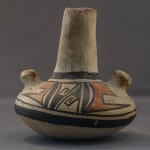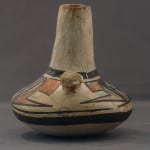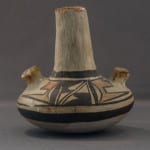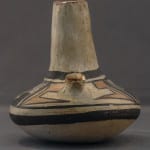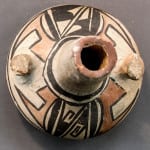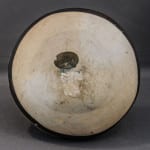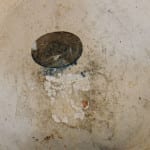First People potters of the Southwest have long produced canteens necessary to carry drinking water to the cornfields. These utility canteens carry from several cups to a quart or more of water. (See “utility ware” in the Index of Categories for the variety of such canteens in this collection.) Wade and Cooke write that around 1900 Hopi-Tewa potters began making miniature canteens (2012:172). Too small to be a source of drinking water, these items were intended solely for the tourist market. Within this collection, this evolution can be traced by reviewing “Canteens” in the Index of Categories, and it also can be seen in the evolution of Nampeyo’s work (see “Nampeyo Unsigned” in the Index of Artists). Obviously canteen 2013-02 is sized to easily pack into a tourist’s suitcase and is not meant to carry water.
More than half the height of canteen 2013-02 is accounted for by a tall, narrow spout. The lower body of the vessel is disk-shaped with all of the decoration on the upper surface. The body of the vessel is formed of a coarse clay that fires brick red, which Wade and McChesney write is unusual but known among “Polacca C” and “Polacca D” ware (1981:144 and 455).
The slip is white but uncrackled, in contrast to earlier Polacca ware. The lip of the canteen is painted red. Thick-above-thin framing lines encircle the base of the spout. Thin-above-thick framing lines form the lower boundary of the design, with a spirit-break line only in the thin line of this lower set. The design is angular with some suggestion that negative space is being considered; both patterns are characteristic of the “Sikyatki Revival” beginning around the turn of the century and not at all characteristic of the earlier Polacca tradition.
Miniaturization in response to the tourist trade began in the 1880s—shortly after the establishment of a training post at Keam’s Canyon (Wade and McChesky 1981:143), so it is likely that canteen 2013-02 was made during the last 20 years of the 19th Century. The angular design suggests that it was made during the latter part of this range. A larger (5.25″ X 7″) canteen of very similar shape is part of the collection of The Arizona State Museum, Tuscon (catalog #E5724), has similar angular designs, and is dated 1900.


